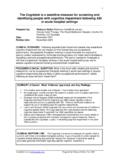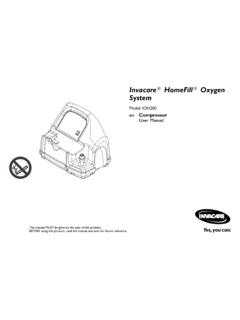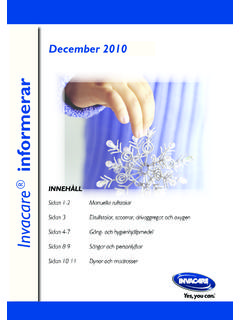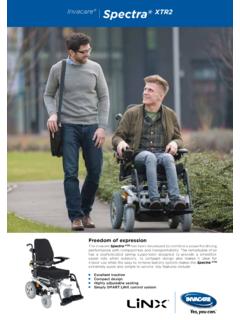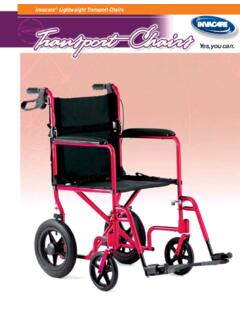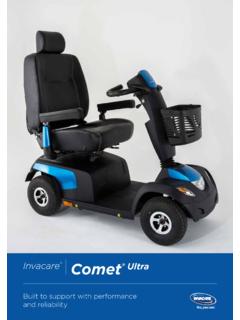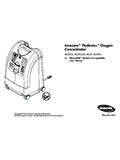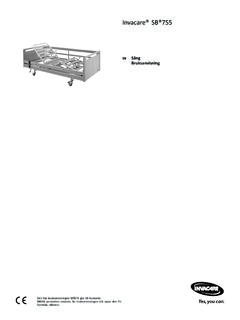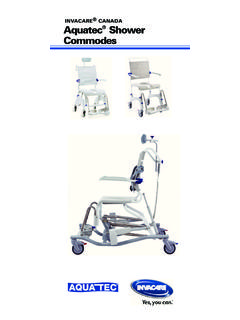Transcription of When seated in a wheelchair, how many degrees tilt …
1 Prepared by Karen Fermin and Michelle Wellard, September 20021 When seated in a wheelchair, how many degrees tilt is neededto improve postural stability for function in chidren with aneurological disorder?Prepared by:Karen FerminOccupational Therapist, Northcott Society, SydneyMichelle WellardOccupational Therapist, Sylvanvale School and EarlyLearning Service, SydneyDate:2 September 2002 Due for review:September 2004 Clinical Question When seated in a wheelchair, how many degrees tilt is needed to improvepostural stability for function in children with a neurological disorder? Clinical ScenarioOccupational therapists working with children with a neurological disorderoften prescribe tilt in space wheelchairs to improve postural stability andenhance function. In most situations clinical decision making is based ona therapists experience rather than evidence based in space is a costly feature to add to a wheelchair.
2 Justifying the needfor this feature is an increasingly more difficult task, as available fundingdoes not equate to the equipment needs of people with a the current economic climate we as prescribers of equipment must beaccountable and able to provide evidence to justify cost /benefits. What isthe evidence that the provision of tilt in a child s wheelchair assists toimprove postural stability and function?Summary of Key Findings 2 studies (case series) were located that met the inclusion/exclusioncriteria 11 expert opinions were also located and appraisedClinical Bottom LineCurrently available literature does not substantiate the use of tilt to improvepostural stability for function in children with a neurological disorder. Eachcase for tilt in space should be individual and methods as outlined in theresearch may be a useful starting point for this by Karen Fermin and Michelle Wellard, September 20022 MethodologySearch StrategyUsing the levels of evidence as defined by the NHMRC (2000), the searchstrategy aimed to locate the following study designs:Level ISystematic reviews and meta-analyses;Level IIRandomised controlled trials Level IIIC ontrolled trials, cohort or case-control analytic studies;Level IVCase series: Post-test only, Pre-test/Post-test.
3 Level VExpert opinion including literature/narrative reviews, consensusstatements, descriptive studies and individual case search was also conducted for clinical practice guidelines based on theselevels of Terms Patient/Client:o Children with a neurological disorder/disease/conditiono Children with a physical disabilityo Paediatrics/pediatricso Neuromuscular disorderso Developmental disabilityo Cerebral Palsyo Muscular Dystrophyo Spina Bifida Intervention:o degrees of tilt in a wheelchairo Tilt in spaceo Gravity assisted positioning Comparison:o Nil Outcome:o Improved postural stabilityo Improved postural alignmento Improved functiono Improved/increased comforto Functional head positionSites/Resources Searched Guidelineso National Association of Neurological OT s (NANOT)o NHMRCo New Zealand Guidelines Groupo HealthbasePrepared by Karen Fermin and Michelle Wellard, September 20023o UK Guidelineso Scottinsh Intercollegiate Guidelines Network (SIGN)o Clearing house Systematic Reviewso Cochraneo DAREo PEDroo Centre for Clinical Effectiveness (Monash University) General Researcho Pubmedo Medlineo CINAHL Othero Tania Roncolato (Seating Clinician, Invacare)o Iona Novak (Research Fellow, Spastic Centre)
4 O RESNAI nclusion/Exclusion CriteriaInclusion Criteria Studies relating to paediatrics Studies only relating to functional outcomes Studies published in EnglishExclusion Criteria Studies that discussed functional outcomes in relation to pressure relief Articles based on an authors expert opinion Prepared by Karen Fermin and Michelle Wellard, September 20024 Results13 relevant studies were located and categorised as follows:Table 1: Study designs of articles retrieved by searchMethodology of StudiesRetrievedNumberLocatedSources of EvidenceClinical Practice Guidelines(Evidence Based)0N/ASystematic Reviews or Meta -Analyses0N/ARandomised Controlled Trials 0N/AControlled trials, cohort orcase-control analytic studies0N/ACase series:Post-test only, Pre-test/Post-test2 Iona Novak x 1 CINAHL x 1 Expert opinion includingliterature/narrative reviews,consensus statements,descriptive studies11 CINAHL x 1 Tania Roncolato x 10 Specific ResultsDue to the low level of evidence found, all studies located were criticallyappraised, so as to report on current findings in order to suggest alternativeresearch OF EVIDENCESTUDY 1 Nwaobi, (1987).
5 Seating orientations and upper extremity function inchildren with cerebral palsy. Physical therapy, 67(8) determine the effect of body orientation on upper extremity function inchildren and adolescents with cerebral The sample consisted of 13 children with cerebral palsy aged between 8and 16 years. 10 were diagnosed as spastic and 3 as athetoid cerebralpalsy. No children had an intellectual disability or were on medication. Baseline data was taken on upper extremity and head control and given arating of poor, fair, good or excellent. The tool used was not described. All children were positioned in the same positioning device, with a switchplaced in the middle of a tray in front of them. Each child was then given the same upper extremity activity to do (endresult was to hit the switch) and their speed was by Karen Fermin and Michelle Wellard, September 20025 The seat was randomly moved between 0, 15 (anterior and posterior) and30 degrees .
6 This resulted in 8 functional scores (0, 15 (ant and post), 30and then a retest of these 4 positions) Outcome Measure recorded was the performance time of a prescribedupper extremity activity in four different seating orientations. The four positions were repeated in reverse sequence to evaluate thereliability of each result, in each position, and the influence of time on theresults. Trials were repeated if subject became A statistically significant result (p< ) was found between using 0 and 15(anterior and posterior) degrees tilt. Best time was at 0 degrees tilt duringthe retest phase. Children with spastic cerebral palsy generally did better than those withathetoid cerebral palsy Children with spastic cerebral palsy generally improved during the retestphase of the trial (practice effect). Children with athetoid cerebral palsy generally did worse during the retestphase of the trial.
7 For further detail see table 1, 2 and figure and Clinical ImplicationsAuthor That orientation of body in space affects upper extremity function forchildren with types of disorders involved in this study Suggest need for intragroup evaluation of research data obtained frompersons with cerebral palsy. Suggests that the upright position should be used to re-educate andstrengthen voluntary movement patterns in these individualsReviewer Some statements in the discussion relate to expert opinion and were notdirectly evaluated in the study or could not be seen as valid conclusionsconsidering the small nature of the study. Eg, Thus, although the childmay appear to be comfortable and well seated in these positions (15 and30 tilt), the results of this study show that these are not the preferredpositions for maximizing the type of upper extremity function used for thisstudy.
8 Extraneous variables were not measured in this study but still discussedas possible indicators as to why tilt was not as successful eg, need forhorizontal eye contact, fatigue of using arms against gravity, increase inintensity of abnormal patterns over time. Can t generalise these results as possibly suggested by this author Although the results are statistically significant, the author does not saywhether the results are of clinical significance. The study design was limited and no confidence intervals were provided(nor were these able to be calculated). As a result, can be made on theclinical significance of the by Karen Fermin and Michelle Wellard, September 20026 STUDY 2 Angelo, J. (1993). Using single-subject design in clinical decision making:The effects of tilt-in-space on head control for a child with cerebralpalsy. Assistive Technology, 5: determine the effect of tilt in space on head control for a child with Observed a 9yr old girl with cerebral palsy once a week for 10 weeks.
9 This took place in a non graded mainstream classroom. Observation was made on the same day each week for 2 hours in themorning. 0, 15 and 30 degrees tilt where applied randomly every 20 minutes duringthe 2 hour period. Time sampling recording was used. Data collected each minute over 15minute period. Score: 1 = faced activity 2 = unclear if faced activity 3 = didn t face activity Data recorded on activities the subject Given in graph form as a % of time the child spent directly facing activityover the number of sessions: 0 - 15 - 30 - and Clinical ImplicationsAuthor Although a small effect size, the study did indicate that this child had moreconsistent head positioning at 15 . This information would be generalised to the child s other activities so thatshe would fatigue less quickly. Concluded that if a subject has high energy and motivation and toleratesan upright position, should be tilted to 15.
10 As they tire, change the tilt to30 for more trunk and head control. The author stated that statistical analysis was not necessary in this Can t generalise these results to other activities as possibly suggested bythis author No base line data taken of how she was positioned prior to this studytaking place No information given on severity of disability, quality of tone, other existingdisabilities eg CVIP repared by Karen Fermin and Michelle Wellard, September 20027 May be useful to replicate for one client only at a time as an observationtool to measure the effect of tilt in space. Other extraneous factors suchas fatigue, type of activity, time of day, existing conditions were notaccounted for in this OF LEVEL 5 ARTICLES EXPERT OPINIONSS everal articles related to degree of wheelchair tilt were excluded for thefollowing reasons:(a) only discussed tilt in space in regards to pressure control,(b) looked only at recline, and(c) looked only at Scmeler, , Boninger, , Cooper, R.
